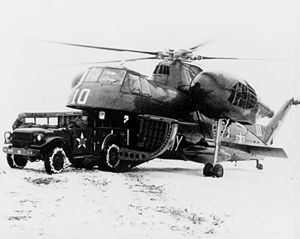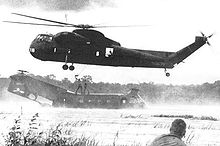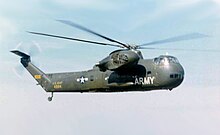Sikorsky S-56
| Sikorsky S-56 | |
|---|---|
 An H-37 is loaded with a vehicle |
|
| Type: | Transport helicopter |
| Design country: | |
| Manufacturer: | |
| First flight: |
December 18, 1953 (XHR2S-1) |
| Commissioning: |
October 1955 |
| Number of pieces: |
154 |
The Sikorsky S-56 was a piston engine powered American transport helicopter that first flew in 1954.
With a crew of 3 men, 36 passengers or 5,000 kg of freight could be transported. For reasons of space, the two radial engines of the drive were housed in two gondolas on the side of the fuselage in a shoulder-wing arrangement. In addition to a sliding door on the side , the S-56 had two wing doors in the bow to accommodate the cargo , which made it passable even for smaller vehicles.
The main rotor was designed in such a way that the flight could be continued even with a missing rotor blade (for example after being hit by fire).
history
After the start of production of the Sikorsky S-55 , the Sikorsky designers began planning a heavy combat zone transport helicopter. The first flight took place on December 18, 1953. It was Sikorsky's first twin-engine helicopter and the largest helicopter in the Western Hemisphere at the time .
The S-56 was originally designed and built for the US Marine Corps . In the course of time, however, the United States Army developed into the main customer; almost two thirds of the total production was used by the US Army as the H-37A Mojave . At the Marine Corps, some specimens were given a powerful AN / APS-20 E radar antenna with a large radome and the designation HR2S-1W as a patrol helicopter .
During the Vietnam War , the S-56 was often misused as a crane helicopter . So the Sikorsky S-60 was developed , which had numerous components of the S-56 , but never got beyond the test stage. Based on this S-60 , the Sikorsky S-64 Skycrane was later designed.
A total of 148 S-56s were built. In his role as a transport helicopter, he was replaced by the Boeing Vertol CH-47 .
variants
- XHR2S-1
- Four prototypes
- HR2S-1
- Standard version with modified engine nacelles and main landing gear with double tires. 55 copies built.
- HR2S-1W
- Early warning variant. Two copies built.
- H-37A Mojave (CH-37A after 1962)
- US Army version of the HR2S-1, initially tested as the YH-37. Compared to the prototype, a fin was added to the back of the fuselage and the rotor hub cladding was modified. 94 copies built.
- H-37B Mojave (CH-37B after 1962)
- All but four of the H-37A were equipped with a redesigned cargo door, an automatic stabilization system and crash-proof fuel cells.
- CH-37C
- Renaming of the HR2S-1 after 1962
Military users
Technical specifications

| Parameter | Data |
|---|---|
| Rotor diameter | 21.95 m |
| Hull length | 19.57 m |
| overall length | 26.80 m |
| height | 6.71 m |
| Preparation mass | 9,450 kg |
| Takeoff mass | 14,000 kg |
| crew | 3 |
| Top speed | 209 km / h |
|
Hover altitude with ground effect |
1,370 m |
| Service ceiling | 2,652 m |
| Range | 235 km |
| Engine | 2 Pratt & Whitney R-2800-54 Double Wasp - radial engines with 1545 kW (2,100 PS) each |
See also
Web links
Individual evidence
- ^ Leonard Bridgman (ed.): Jane's All The World's Aircraft - 1959-60 , Sampson Low, Marston & Company Ltd., London 1959, p. 386
